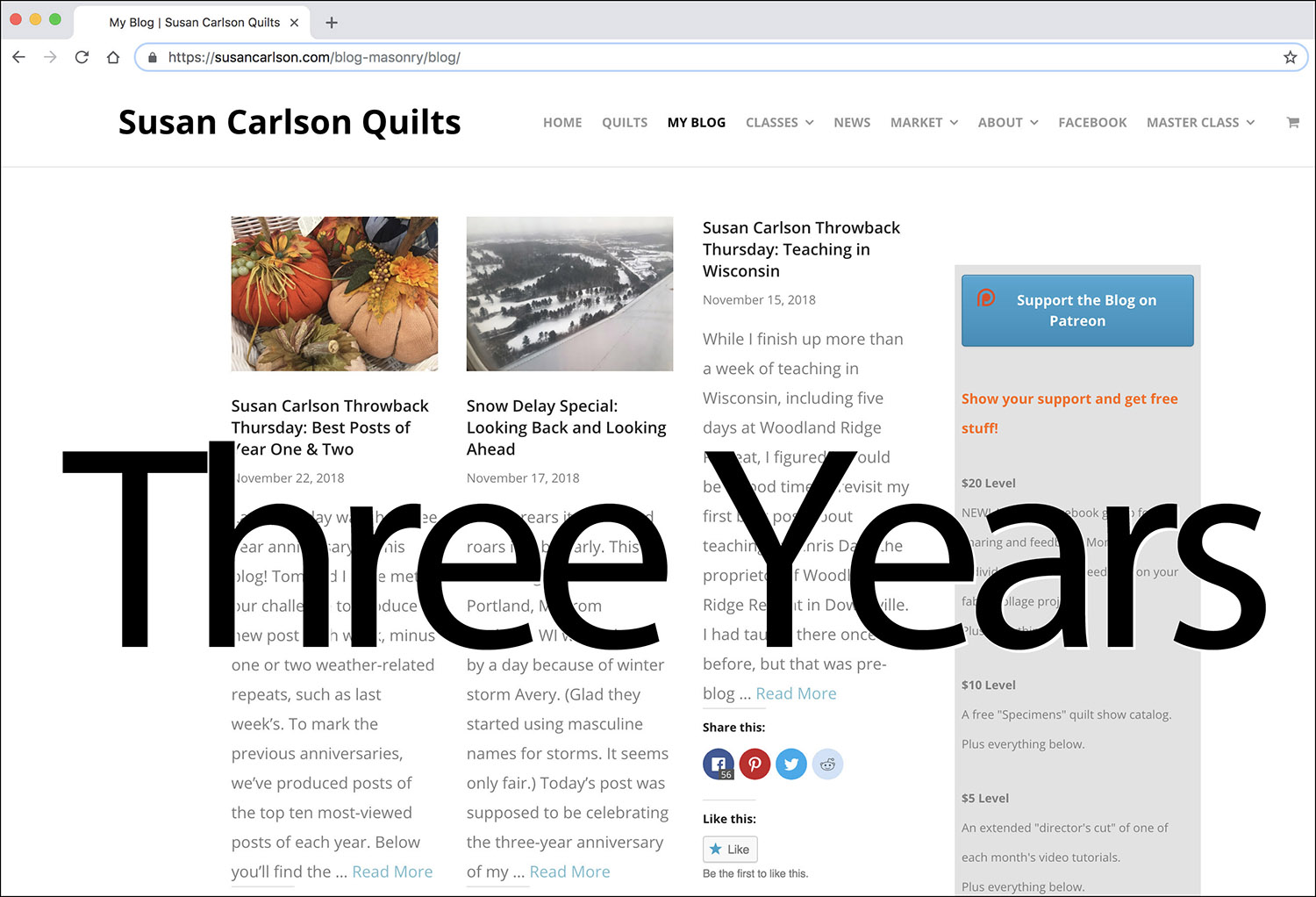I know New Year’s Day is still a few weeks off, but for this blog, the old year just ended and a new one has begun. Our third anniversary passed last week, so it’s time for our annual “Best Of” post. Previous years, I’ve used site statistics to choose the top ten—visits, page views, and so on—but maybe I’m in a more contemplative mood. I’m not willing to leave the choice up to some soulless algorithm.
The blog is more than a way I convey information to you about fabric collage techniques. It also acts as a sort of diary or journal, helping me keep track of all I’ve done over the past year. As I skimmed through the last 52 or so blog posts, I was reminded of the milestones for this year.
March 17: I launched my online class. My attempt to bring fabric collage to those who can’t come to me has been a learning experience for all involved. Look for an update this winter, including the first “module” on a particular subject matter, such as pets, people, or fish, bugs, and butterflies.
April 26: I introduced Throwback Thursday. Since I gain readers all the time, it’s helpful to revisit some old posts for those who missed them first time around.
May 26: I created the Fabric Collage Toolkit, an online page with links to purchase all the specialized gadgets and supplies you need for fabric collage.
September 8: Thanks to readers, this blog won the Best Art Quilting Blog award from National Quilters Circle. They have since posted an interview with me on their website.
September 19: My exhibit at the New England Quilt Museum opened. The show runs through December 30, 2018.
Events also worth remembering: my second trip to Australia in April and “local” exhibits and lectures here in Maine and in New Hampshire.
Many of my favorite posts of the year are about fabric collage technique. Others address the more abstract concepts of fabric collage (and art in general). One doesn’t address fabric collage at all. Since my criteria for choosing them varied so much, for each post below I describe why it was chosen.
In class I give a demo on how to cut fabric into workable chunks using appliqué scissors. Students had long wondered why I use these “pelican-bladed” scissors, so it was time to explain what I find so handy about them. I also liked the title.
It’s pleasing to me when an abstract idea can be used to solve a concrete problem. In this case the problem is narrowing down the infinite choices of color, texture, and subject we all face when beginning a new project. This is a blog post I will have my students read before they come to class.
I love novelty prints and I love surprising people when they find them in my work. I hope this post helps to expand the horizons of what is possible in fabric collage.
This was an important addition to the technique of fabric collage as I practice it. Making fine lines is critical to adding those final all-important details.
Featuring Marilyn Davidson: Fabric Collage as Art and Therapy
This post was an act of bravery and generosity by my friend Marilyn. The way Marilyn uses her art to address a tragic loss and her willingness to share her experience makes me admire her even more, if that’s possible.
This post written by husband Tom was one of the most commented upon posts ever. People shared their experiences of when they were shamed for their lack of ability or just plain interest in art. It really struck a chord with readers.
What I Did This Summer: Or Why Is It so Hard to Stay in the Studio?
The title of this one says it all. If life is all one thing—even if the one thing is fabric collage—it isn’t very much fun. We Mainers cram a lot into the three short months of summer.
Portland, Maine Advanced Students Share Their Favorite Fabric Collage Tips
Not every experiment I try works out, but this experiment of letting the students give their fabric collage hints and tips was a big success.
Opening Reception for Susan Carlson’s Fabric Collage Quilts at NEQM
As an artist, having a solo show is a big deal. I was honored to have my work featured the New England Quilt Museum.
I don’t know why it didn’t occur to me to do this sooner. Not only do I list the tools and supplies, I explain why I use them—why they’re useful or why I use them instead of something else.
Choosing your subject is one of—if not the—first step in any fabric collage quilt. It’s also one of the most important decisions you can make. A good decision will help make the experience a positive one. This is another post that I will have my students read before coming to class.

This is the very first blog I have ever followed and I love it. I had the opportunity to come to your retreat this past October but at the last minute life got in the way. I am definitely waiting every day for your email opening 2019, as I will not miss next year! I love your work and the students give me hope. It’s on my bucket list to come to a retreat. Can’t wait.